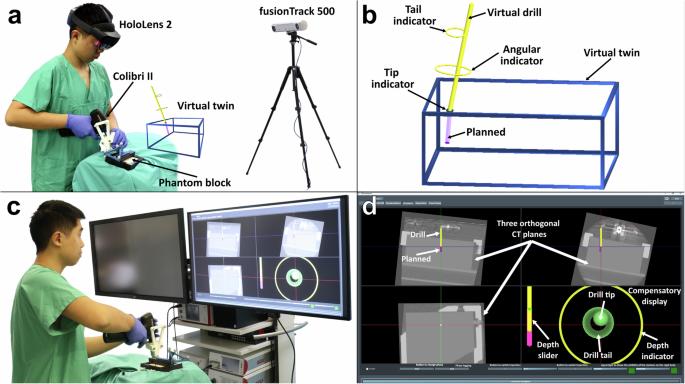使用增强现实技术与传统导航技术随机交叉试验的钻孔轨迹精度和效率
IF 12.4
1区 医学
Q1 HEALTH CARE SCIENCES & SERVICES
引用次数: 0
摘要
手术中的传统导航系统(CNS)需要很强的空间认知能力和手眼协调能力。增强现实导航系统(ARNS)提供三维导航,可以克服这些挑战,但与 CNS 相比,其准确性和效率尚未得到系统评估。在这项随机交叉研究中,36 名来自不同专业背景(外科医生、学生、工程师)的参与者使用 ARNS 和 CNS 对钻孔准确性、时间和感知工作量进行了评估。这项研究首次提供了令人信服的证据,证明 ARNS 和 CNS 在平移误差方面具有可比的准确性。ARNS 在角度和深度误差方面的差异可能是由于有限的立体视觉、硬件限制和设计造成的。尽管如此,ARNS 还是得到了大多数参与者的青睐,包括之前有过导航经验的外科医生,并显示出明显更好的整体用户体验。根据对精确度的要求,ARNS 可以作为 CNS 的可行替代品,用于引导钻孔,并有可能在未来进行优化。本文章由计算机程序翻译,如有差异,请以英文原文为准。


Accuracy and efficiency of drilling trajectories with augmented reality versus conventional navigation randomized crossover trial
Conventional navigation systems (CNS) in surgery require strong spatial cognitive abilities and hand-eye coordination. Augmented Reality Navigation Systems (ARNS) provide 3D guidance and may overcome these challenges, but their accuracy and efficiency compared to CNS have not been systematically evaluated. In this randomized crossover study with 36 participants from different professional backgrounds (surgeons, students, engineers), drilling accuracy, time and perceived workload were evaluated using ARNS and CNS. For the first time, this study provides compelling evidence that ARNS and CNS have comparable accuracy in translational error. Differences in angle and depth error with ARNS were likely due to limited stereoscopic vision, hardware limitations, and design. Despite this, ARNS was preferred by most participants, including surgeons with prior navigation experience, and demonstrated a significantly better overall user experience. Depending on accuracy requirements, ARNS could serve as a viable alternative to CNS for guided drilling, with potential for future optimization.
求助全文
通过发布文献求助,成功后即可免费获取论文全文。
去求助
来源期刊

NPJ Digital Medicine
Multiple-
CiteScore
25.10
自引率
3.30%
发文量
170
审稿时长
15 weeks
期刊介绍:
npj Digital Medicine is an online open-access journal that focuses on publishing peer-reviewed research in the field of digital medicine. The journal covers various aspects of digital medicine, including the application and implementation of digital and mobile technologies in clinical settings, virtual healthcare, and the use of artificial intelligence and informatics.
The primary goal of the journal is to support innovation and the advancement of healthcare through the integration of new digital and mobile technologies. When determining if a manuscript is suitable for publication, the journal considers four important criteria: novelty, clinical relevance, scientific rigor, and digital innovation.
 求助内容:
求助内容: 应助结果提醒方式:
应助结果提醒方式:


